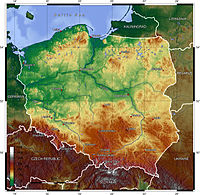
Photo from wikipedia
Abstract Loess-like deposits in the Orava Basin are aeolian sediments that were laid down during Pleistocene three cold periods: MIS 2-5d, MIS 6-10, and MIS 12-19. These deposits lie at… Click to show full abstract
Abstract Loess-like deposits in the Orava Basin are aeolian sediments that were laid down during Pleistocene three cold periods: MIS 2-5d, MIS 6-10, and MIS 12-19. These deposits lie at the upper portion of glaciofluvial fans associated with the Czarny Dunajec River in the Orava Basin and are the youngest lithostratigraphic division that is present there. Results of granulometric analyses place their modal grain size in the coarse silt and fine sand fractions (sediment type 1.a). Geomorphic interactions between local topography, aeolian movements of sand and distribution of dust played the leading role in formation of these deposits. Two series of sediments have been distinguished: Series A which represents proximal depositional provenance, and Series B – distal depositional provenance. The source of the loess-like deposit material must have been local as the Orava Basin is isolated from foreland by highly elevated mountain ranges. Glaciofluvial sediments were deflated then laid down on fans at the bottom of the Orava Basin by rivers draining the western Tatra Mountains. Also ‘cannibalized’ were top portions of loess-like deposits that had accumulated during earlier Pleistocene cold periods. Fine sediment was also deflated from regolith mantle that formed on the slopes of surrounding hills. This conclusion is based on the results of analyses of microtextures of sand- and silt-sized grains. Grains with surfaces that were primarily shaped by chemical weathering (coated) and by mechanical weathering (fresh fractured) predominate both fractions. These sand grains were transported over a short distance; they were not subject to repeated redeposition.
Journal Title: Aeolian Research
Year Published: 2019
Link to full text (if available)
Share on Social Media: Sign Up to like & get
recommendations!